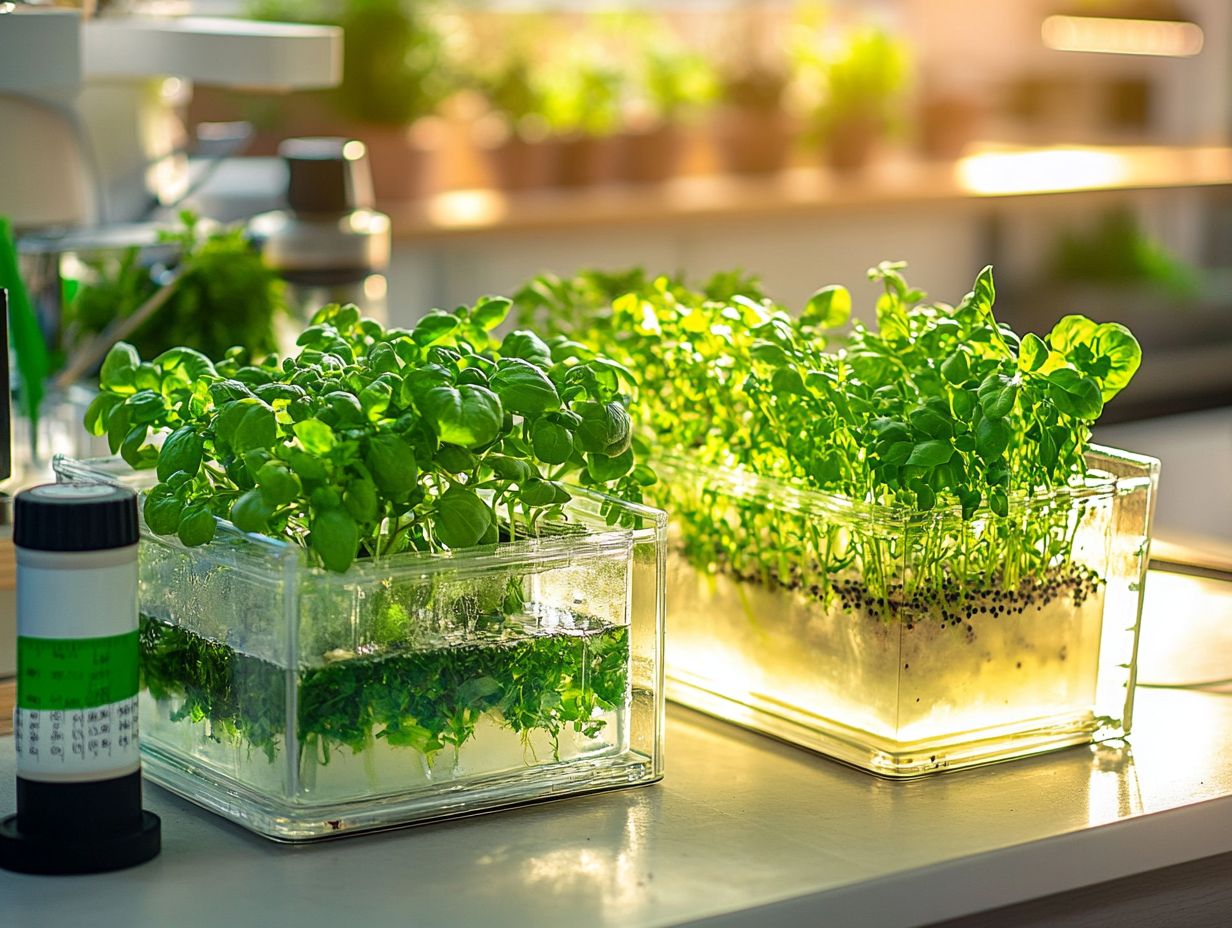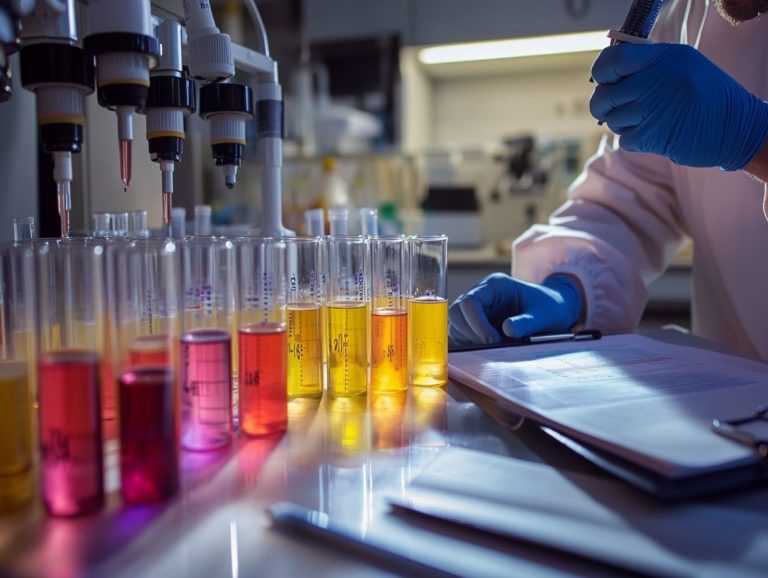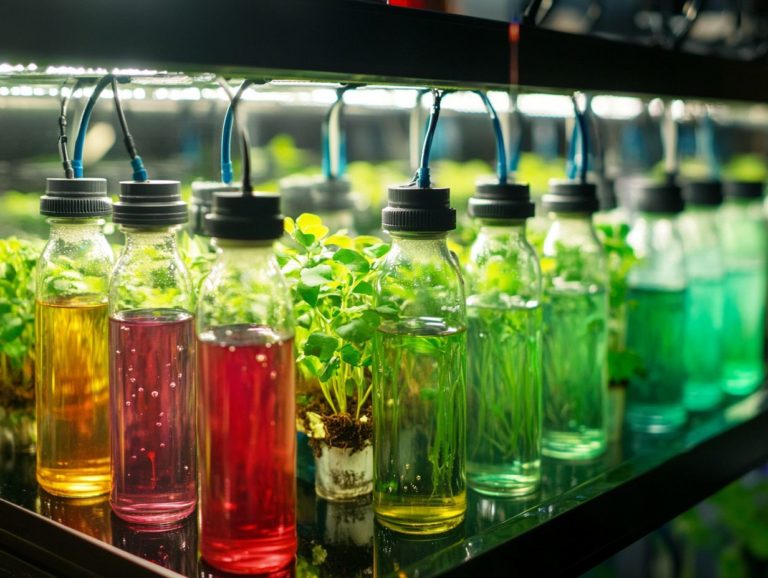How to Use Nutrients for Optimal Hydroponic Growth
Hydroponics has transformed the way you cultivate plants, presenting a soil-less method that optimizes both efficiency and yield.
Grasping the effective use of nutrients is vital for the success of your hydroponic systems. This article delves into the benefits of nutrient application, outlines the essential nutrients necessary for optimal growth, and offers expert guidance on choosing and applying these nutrients with precision.
It emphasizes the importance of monitoring nutrient levels, ensuring your plants receive the specific elements they need for robust health.
Dive into this guide and supercharge your hydroponic gardening journey!
Contents
- Key Takeaways:
- Benefits of Using Nutrients in Hydroponic Growth
- Essential Nutrients for Hydroponic Plants
- How to Choose the Right Nutrients for Your Plants
- Proper Application of Nutrients in Hydroponic Systems
- Monitoring and Adjusting Nutrient Levels
- Frequently Asked Questions
- 1. How do I determine which nutrients to use for optimal hydroponic growth?
- 2. Can I use regular plant fertilizer for hydroponic growth?
- 3. How often should I replenish the nutrient solution in my hydroponic system?
- 4. Can I mix different types of hydroponic nutrients together?
- 5. How do I know if my plants are getting enough nutrients?
- 6. Can I adjust the nutrient levels in my hydroponic system?
Key Takeaways:

- Proper nutrient application is essential for optimal hydroponic growth, leading to improved plant growth.
- Identify and understand the key nutrients needed for your plants, including Nitrogen, Phosphorus, and Potassium. Consider factors such as plant type and growth stage when choosing the right nutrients.
- Regular monitoring and adjustment of nutrient levels is crucial for maintaining a healthy hydroponic system and ensuring successful plant growth.
What is Hydroponic Growth?
Hydroponic growth is a groundbreaking method that allows you to cultivate plants without soil, utilizing nutrient solutions to deliver essential nutrients directly to the roots. This exciting method boosts plant growth like never before by providing balanced nutrition, leveraging systems like nutrient film technique (a method where a thin film of nutrient solution flows over the roots) and deep-water float systems (where plants float on the surface of water with their roots submerged) to facilitate the absorption of both large nutrients and small nutrients.
Hydroponics is more than growing plants. It creates a controlled environment that maximizes growth and minimizes waste, allowing for year-round cultivation.
Soilless media, like clay pellets or Rockwool, enhance nutrient uptake and moisture retention, resulting in vigorous plant health. Each hydroponic system operates on specific principles; for instance, aeroponics elevates plants in a mist environment, delivering nutrients even faster.
These systems significantly cut down on pests and diseases, giving your plants a safe space to thrive.
With the right balance of light, water, and nutrients, the flexibility of hydroponics enables you to adapt your practices to suit various growing conditions, supporting the future of sustainable agriculture, particularly for crops like Tomatoes, Basil, and Strawberries.
Benefits of Using Nutrients in Hydroponic Growth
Utilizing nutrient solutions in hydroponic growth offers a multitude of advantages that greatly elevate both the health and productivity of your plants. By providing essential nutrients directly to the roots, you can witness remarkable enhancements in plant growth, including increased yields, superior nutrient absorption, and heightened resistance to diseases and pests.
Nutrient solutions meticulously crafted for hydroponics enable you to achieve precise pH balance, manage soluble salts, and optimal electrical conductivity, while using the best nutrient brands for hydroponic gardens to further nurture the development of strong, thriving plants.
Improved Plant Growth and Health
Improved plant growth and health stand out as some of the most remarkable benefits of hydroponics. The right mix of essential nutrients is crucial for nurturing thriving plants. By ensuring that your plants receive all the necessary macronutrients and micronutrients like Nitrogen, Phosphorus, and Iron you can significantly reduce the risks of nutrient deficiencies, such as nitrogen and iron deficiencies. This enhances overall chlorophyll production and promotes vibrant leaf health.
Each nutrient plays a unique role. Nitrogen is essential for robust leaf and stem growth, while Phosphorus is vital for energy transfer and root development. Micronutrients like Iron and Magnesium hold immense importance as well, influencing critical processes such as photosynthesis. When plants show signs of distress, like yellowing leaves or stunted growth, it often indicates nutrient-related issues.
Recognizing these symptoms early allows you to adjust your nutrient solutions to restore balance and prevent any further decline in plant health. Understanding the intricate relationship between these nutrients and plant vitality is key to mastering successful hydroponic cultivation, especially when considering organic nutrient options for hydroponic systems.
Essential Nutrients for Hydroponic Plants

Essential nutrients are vital for the flourishing growth of hydroponic plants. Both macronutrients and micronutrients play distinct roles in their development, including Zinc and Manganese.
Macronutrients like Nitrogen, Phosphorus, and Potassium are needed in larger quantities, while micronutrients such as Calcium, Magnesium, and Zinc are crucial in smaller amounts. Understanding the role of micronutrients in hydroponics can help you grasp the balance of these nutrients, ensuring optimal plant health and growth within your hydroponic systems.
Identifying and Understanding Key Nutrients
Identifying and understanding key nutrients is the key to unlocking vibrant plant health in hydroponic systems. Each nutrient plays a unique role in growth and development. By recognizing symptoms of nutrient deficiencies such as discoloration or stunted growth you can make timely adjustments to your nutrient solutions, ensuring your plants receive the necessary sustenance for robust development.
By mastering this knowledge, you can supercharge your yields and improve the overall vitality of your plants. For instance, if you notice yellowing leaves, it may signal a lack of nitrogen, while browning leaf tips could indicate insufficient potassium. Addressing these deficiencies typically involves fine-tuning your nutrient mix, possibly by using chelated fertilizers special fertilizers that help plants absorb nutrients more effectively or specialized solutions that efficiently deliver the required elements right to the plant roots.
By regularly monitoring nutrient levels alongside their corresponding symptoms, you can establish a balanced environment that fosters optimal photosynthesis, root development, and flowering. This proactive approach ultimately leads to healthier, more productive crops when combined with using nutrient solutions in different growing systems.
How to Choose the Right Nutrients for Your Plants
Selecting the right nutrients for your plants is a crucial decision in hydroponic gardening. It demands thoughtful consideration of several factors to achieve peak growth and vitality. You must consider the type of plants you re nurturing, their specific growth stages, and the surrounding environmental conditions all of which significantly influence the nutrient solution you should employ.
Striking the right balance between macronutrients and micronutrients is essential to maximize your yields and avert potential complications such as nutrient competition (where different nutrients hinder each other’s uptake) and nutrient blockage (when a nutrient prevents the absorption of others).
Factors to Consider and Tips for Selection
When choosing nutrients for your hydroponic systems, consider several important factors:
- Water quality
- Electrical conductivity
- Specific plant needs, such as Peppers and Tomatoes.
It s essential to understand how these elements interact to create a thriving growth environment. High levels of impurities in your water can lead to nutrient lockout, preventing plants from absorbing vital minerals.
Regularly test and adjust your water quality. Invest in a quality filtration system to improve purity significantly. Monitor electrical conductivity with a reliable meter to pinpoint nutrient concentration and make necessary adjustments for optimal absorption.
Calibrate your sensors and perform routine checks to maintain an ideal nutrient balance. This practice fosters robust plant development, which is essential for successful hydroponics.
Proper Application of Nutrients in Hydroponic Systems

Properly applying nutrients is crucial for the success of hydroponic systems. It greatly influences plant health and overall growth outcomes.
By understanding various nutrient delivery methods, such as the nutrient film technique and deep-water float systems, you can optimize nutrient supply to your plants.
This knowledge ensures your plants receive essential nutrients while minimizing risks of over-application or nutrient antagonism when one nutrient prevents the absorption of another, affecting plant health.
Methods and Techniques for Nutrient Delivery
Explore the exciting world of nutrient delivery methods in hydroponics! You ll find effective techniques, such as:
- Nutrient film technique
- Deep-water float systems
- Aeroponics
- Drip irrigation systems
Each method offers unique advantages, allowing you to optimize nutrient uptake and manage plant health efficiently, ultimately leading to improved yields.
Aeroponics uses a misting technique to deliver nutrients directly to the roots, fostering rapid growth and water efficiency. However, it requires careful monitoring to prevent over-saturation.
Drip irrigation systems provide precise control over nutrient levels through periodic drips. However, they can be more labor-intensive regarding setup and maintenance.
By evaluating these methods, determine the best approach to achieve maximum growth and resource efficiency for your hydroponic endeavors.
Monitoring and Adjusting Nutrient Levels
Monitoring and adjusting nutrient levels in hydroponic systems is crucial for plant health. Any imbalances can lead to nutrient deficiencies or toxicities, hindering growth.
Regularly test the pH balance and electrical conductivity levels. This ensures your nutrient solutions remain effective and finely tuned to your plants’ specific needs.
Act now to prevent complications like boron toxicity or calcium deficiency and ensure your plants thrive!
Importance of Regular Testing and Maintenance
The significance of regular testing and maintenance in hydroponic systems is paramount; it directly influences both plant productivity and health. By consistently monitoring your setup, you can catch early signs of issues, allowing for timely interventions to rectify nutrient deficiencies or imbalances that could otherwise diminish your yields.
To achieve optimum performance, it’s wise to test nutrient solutions at least once a week and check pH levels multiple times throughout the week. Pay attention to plant symptoms like yellowing leaves, stunted growth, or discoloration, as these can offer vital clues regarding the health of your system. For a deeper understanding, refer to Understanding Hydroponic Nutrient Solutions. A meticulous approach enhances the growing environment and helps you prevent issues before they escalate.
Make these practices your top priority to cultivate a robust hydroponic ecosystem that not only allows your plants to thrive but also sets the stage for a bountiful harvest.
Frequently Asked Questions
Here are some common questions about hydroponic growth, along with helpful answers to guide you.

1. How do I determine which nutrients to use for optimal hydroponic growth?
The best way to determine which nutrients to use is to first understand the specific nutrient requirements of the plants you are growing. Research the ideal nutrient levels for the type of plant, and then choose a hydroponic nutrient solution that closely matches those levels.
2. Can I use regular plant fertilizer for hydroponic growth?
No, regular plant fertilizers are not suitable for hydroponic growth. Hydroponic plants require a specialized nutrient solution specifically formulated for their growth needs. Regular fertilizers may contain chemicals or additives that can harm the plants and disrupt the delicate balance of the hydroponic system.
3. How often should I replenish the nutrient solution in my hydroponic system?
The frequency of replenishing the nutrient solution depends on various factors such as the type of plants, the size of the system, and environmental conditions. It is generally recommended to change the nutrient solution every 1-2 weeks to ensure optimal plant growth.
4. Can I mix different types of hydroponic nutrients together?
In most cases, it is not recommended to mix different types of hydroponic nutrients. Each type of nutrient solution is specifically designed to provide the necessary nutrition for the plants. Mixing different types may result in unbalanced nutrient levels, negatively affecting plant growth.
5. How do I know if my plants are getting enough nutrients?
Wondering if your plants are thriving? Regularly monitor their growth and health. If the plants appear stunted, discolored, or wilted, it could be a sign of nutrient deficiency. It’s also important to check and adjust the nutrient levels in the solution to ensure they are within the recommended range for the specific plants.
6. Can I adjust the nutrient levels in my hydroponic system?
Yes, you can adjust the nutrient levels in your hydroponic system. However, it is important to do so carefully and gradually to avoid disrupting the delicate balance of the system. Test the nutrient levels regularly and make small adjustments as needed to ensure optimal plant growth.
Ready to get started with hydroponics? Dive in and watch your plants flourish!






